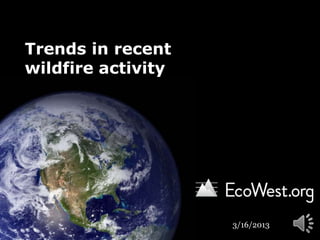
Trends in recent wildfire activity
- 1. Trends in recent wildfire activity 3/16/2013
- 2. Number of U.S. wildfires: 1961-2012 300,000 250,000 200,000 Change in reporting 150,000 100,000 50,000 0 Source: National Interagency Fire Center 3/16/2013 2
- 3. Number of U.S. wildfires: 1990-2012 120,000 100,000 80,000 60,000 40,000 20,000 0 Source: National Interagency Fire Center 3/16/2013 3
- 4. Acres burned by U.S. wildfires: 1961-2012 12,000,000 10,000,000 8,000,000 6,000,000 4,000,000 2,000,000 10-year moving average 0 Source: National Interagency Fire Center 3/16/2013 4
- 5. Average size of U.S. wildfires: 1961-2012 160 140 120 100 80 60 40 10-year moving average 20 0 Source: National Interagency Fire Center 3/16/2013 5
- 6. Average size of U.S. wildfires: 1990-2012 160 140 120 100 80 5-year 60 moving average 40 20 0 Source: National Interagency Fire Center 3/16/2013 6
- 7. Number of fires larger than 100,000 acres 16 14 12 10 8 6 4 2 0 1997 1998 1999 2000 2002 2003 2004 2005 2006 2007 2008 2009 2010 2011 2012 Source: National Interagency Fire Center 3/16/2013 7
- 8. Download more slides and other resources ecowest.org 3/16/2013 8
Notas do Editor
- Narrative: The number of wildfires and acreage burned varies a lot from year to year. Although the government has reportedthese statistics for decades, the tracking methodology has varied over time, especially when it comes to small fires.As you can see, there was a major surge reported in the late 1970s and then a sharp dropoff in the early 1980s. Since then, there has been more consistent reporting.Source:National Interagency Fire CenterURL:http://www.nifc.gov/fireInfo/fireInfo_stats_totalFires.htmlNotes:2004 fires and acres do not include state lands for North Carolina; figures prior to 1983 may be revised as NICC verifies historical data; stats after 1983 were compiled by states and agencies.
- Narrative: Here’s a close-up of the past quarter century. There number bounces around from year to year, but is more or less steady. In an average year, there are nearly 80,000 wildfires in the nation, but the vast majority of these are small blazes that are confined to a few acres or less. As a rule of thumb, wildland firefighters contain more than 95 percent of blazes in the so-called initial attack, but the relatively small number of fires that do escape are responsible for more than 95 percent of the acreage burned.Source:National Interagency Fire CenterURL:http://www.nifc.gov/fireInfo/fireInfo_stats_totalFires.htmlNotes: 2004 fires and acres do not include state lands for North Carolina; figures prior to 1983 may be revised as NICC verifies historical data; stats after 1983 were compiled by states and agencies.
- Narrative: If we turn to acreage burned, we can see that there’s a lot of variability from year to year—from around 1 million to 10 million acres annually—but there has been an upward trend in recent years. The blue line represents a 10-year moving average. Source:National Interagency Fire CenterURL:http://www.nifc.gov/fireInfo/fireInfo_stats_totalFires.htmlNotes:2004 fires and acres do not include state lands for North Carolina; figures prior to 1983 may be revised as NICC verifies historical data; stats after 1983 were compiled by states and agencies.
- Narrative: Another way of looking at this data is to calculate the average size of fires. Because we’re dividing the total acreage burned by the total number of fires, we run into the same problem with the change in reporting in the 1980s, but if you look at the past two decades or so, you can see that the mean size of wildfires has been increasing. Source:National Interagency Fire CenterURL: http://www.nifc.gov/fireInfo/fireInfo_stats_totalFires.htmlNotes:2004 fires and acres do not include state lands for North Carolina; figures prior to 1983 may be revised as NICC verifies historical data; stats after 1983 were compiled by states and agencies.
- Narrative: Here’s a close-up of the past two decades. Source:National Interagency Fire CenterURL:http://www.nifc.gov/fireInfo/fireInfo_stats_totalFires.htmlNotes:2004 fires and acres do not include state lands for North Carolina; figures prior to 1983 may be revised as NICC verifies historical data; stats after 1983 were compiled by states and agencies.
- Narrative: This slide only looks at really big fires—those exceeding 100,000 acres. Since 2000, it has been common for there to be a 10 or more such fires each year. Source:National Interagency Fire CenterURL:http://www.nifc.gov/fireInfo/fireInfo_stats_lgFires.htmlNotes:See also http://www.nifc.gov/fireInfo/fireInfo_stats_histSigFires.html
